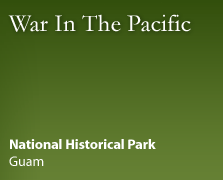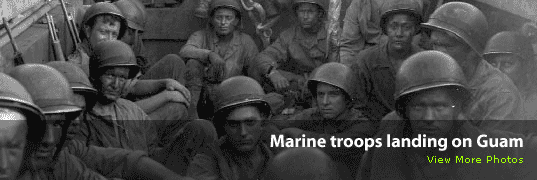| |
On May 1st and 2nd, the War in the Pacific National Historical Park (WAPA) staff paid two visits to Lynda Edwards’ Chamorro classroom at Upi elementary school in Yigo. Prompted by an article she saw in the Pacific Daily News on a WAPA visit to Andersen’s Career Day, Edwards called and and requested a Park Service visit for her students.
Superintendent Eric Brunnemann, Museum Curator Tammy Duchesne, Park Ranger Elizabeth Cruz , Arizona Memorial Museum Association employee Anita Cruz, Ecologist Dwayne Minton, and Ranger Ali Spittler, visite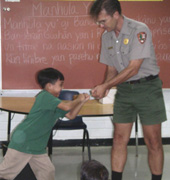 d the elementary school where they gave presentations to six different groups of students. d the elementary school where they gave presentations to six different groups of students.
Eric Brunnemann, an archeologist, talked to the students about Chamorro pre-history and then proceeded to show the students how cordage or rope can be made from coconut palms. The students were fascinated that the vein of palm fronds could be so strong. Eric called on students to help de-vein the frond and then had the students twist the fibers which resulted in a very strong rope. Students were invited to “tug on the rope” and this was a hit! Students loved the opportunity to try and break the cordage and were amazed when they were unable to do so.
Ranger Liz Cruz and Anita Cruz then presented an interesting display on the usages of the 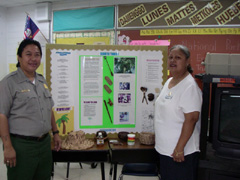 coconut tree, a resource very abundant within the War in the Pacific National Historical Park. Uses of the coconut tree include moisturizing oil for hair and skin, the coconut shells which can be used for drinking cups or food containers, its frawns which can be woven to make mats, baskets, or hats, milk from the coconut for cooking, sennit for tying, securing, and holding things, and water for hydration. The resiliency of the coconut tree and the versatility of its usages were displayed in such a way that the students could appreciate the abundant natural resource that exists on their home island of Guam. In addition to the informative display, Liz then introduced “Guam’s Past and Promise for the Future”, an educational film that addressed such issues as the role of the National Park Service in preserving both natural and cultural resources and leaving these resources unimpaired for future generations, the effects of exotic species, threats to indigenous wildlife, the effects of pollution, and the importance of trying to preserve and protect our environment. coconut tree, a resource very abundant within the War in the Pacific National Historical Park. Uses of the coconut tree include moisturizing oil for hair and skin, the coconut shells which can be used for drinking cups or food containers, its frawns which can be woven to make mats, baskets, or hats, milk from the coconut for cooking, sennit for tying, securing, and holding things, and water for hydration. The resiliency of the coconut tree and the versatility of its usages were displayed in such a way that the students could appreciate the abundant natural resource that exists on their home island of Guam. In addition to the informative display, Liz then introduced “Guam’s Past and Promise for the Future”, an educational film that addressed such issues as the role of the National Park Service in preserving both natural and cultural resources and leaving these resources unimpaired for future generations, the effects of exotic species, threats to indigenous wildlife, the effects of pollution, and the importance of trying to preserve and protect our environment.
Museum Curator Tammy Duchesne brought in cultural items from the War in the Pacific National Historical Park’s museum collection to share with the students. Students enthusiastically and capably identified one of the artifacts as an aviator’s helmet. Students were impressed by this US Army leather helmet that was worn 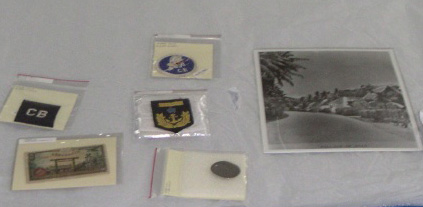 during fighting maneuvers in WWII. The students then marveled at and read the text of an intricately engraved canteen. The text appearing on the GI canteen’s may trace the war efforts back to the Sioux in South Dakota. Tammy also displayed a piece of Japanese currency to show evidence of the Japanese occupation of Micronesia. A pre-war photo of Asan also demonstrated the differences between the village of Asan then and now.The students “ooh’ed” and “ahh’ed” over the photo because they could compare the current appearance of the Asan Beach Unit of the War in the Pacific National Historical Park with the way the park-land looked in the pre-war photo. Students were also very interested in the patches and insignia that were brought in that were originally parts of a CB (construction brigade) uniforms. during fighting maneuvers in WWII. The students then marveled at and read the text of an intricately engraved canteen. The text appearing on the GI canteen’s may trace the war efforts back to the Sioux in South Dakota. Tammy also displayed a piece of Japanese currency to show evidence of the Japanese occupation of Micronesia. A pre-war photo of Asan also demonstrated the differences between the village of Asan then and now.The students “ooh’ed” and “ahh’ed” over the photo because they could compare the current appearance of the Asan Beach Unit of the War in the Pacific National Historical Park with the way the park-land looked in the pre-war photo. Students were also very interested in the patches and insignia that were brought in that were originally parts of a CB (construction brigade) uniforms.
Dwayne Minton (park ecologist) visited Upi elementary school and brought in a piece of coral (an item of War in the Pacific’s Natural History collection ). Dwayne showed students a piece of coral and gave a brief talk on the importance of coral in the i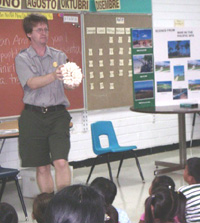 slands’ ecosystems. Dwayne also spoke of the fragility of coral. When discussing the susceptibility of coral to injury and destruction, Dwayne showed National Archive photos from the US Marine Corp that depicted amphibious landing crafts crossing the reefs of Guam. Some of the photos also easily showed the large bomb holes which exist in the Guam’s reef as a result of aerial bombings and showed the reef obstacles that were installed by the Japanese to hinder the American landing efforts. Barbed wire, wooded stakes, mines, and other debris placed on the reefs had an adverse effect on the reefs of Guam. Tire marks from amphibious vehicles driving on the reef were also evident in many photographs. Dwayne’s interesting speech helped raise environmental awareness about the need to treat the reefs with care and respect and additionally pointed out some of the destructive effects that the war had not only on the people and terrestrial resources of Guam, but also on the marine resources. Sadly enough, Dwayne’s major point was that while World War II had destructive effects on Guam’s reefs and marine environment, that the damage to the reefs has been much worse SINCE World War II. In the last decades, we have done more damage to the reefs through our carelessness, destructiveness, and ecologically destructive modern lifeways than the war ever inflicted on the reefs. The students were surprised that modern living and present day habits have been much more harmful to the reefs than World War II. slands’ ecosystems. Dwayne also spoke of the fragility of coral. When discussing the susceptibility of coral to injury and destruction, Dwayne showed National Archive photos from the US Marine Corp that depicted amphibious landing crafts crossing the reefs of Guam. Some of the photos also easily showed the large bomb holes which exist in the Guam’s reef as a result of aerial bombings and showed the reef obstacles that were installed by the Japanese to hinder the American landing efforts. Barbed wire, wooded stakes, mines, and other debris placed on the reefs had an adverse effect on the reefs of Guam. Tire marks from amphibious vehicles driving on the reef were also evident in many photographs. Dwayne’s interesting speech helped raise environmental awareness about the need to treat the reefs with care and respect and additionally pointed out some of the destructive effects that the war had not only on the people and terrestrial resources of Guam, but also on the marine resources. Sadly enough, Dwayne’s major point was that while World War II had destructive effects on Guam’s reefs and marine environment, that the damage to the reefs has been much worse SINCE World War II. In the last decades, we have done more damage to the reefs through our carelessness, destructiveness, and ecologically destructive modern lifeways than the war ever inflicted on the reefs. The students were surprised that modern living and present day habits have been much more harmful to the reefs than World War II.
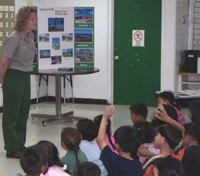
Ali Spittler, park ranger, then gave a brief introductionto the film which would be played. After the film was shown, Ali then enthusiastically asked questions which made the students think about environmental and conservation issues. Her concluding remarks and friendly personality were very well received by the students who were excited to answer questions and share what they learned.
At the end of both days, the staff of the National Park Service reflected on another wonderful opportunity to share their resources and knowledge with the Guam community. The walls of the bright and cheery classroom were well decorated with Chamorro words and phrases and this classroom visit really brought into perspective the richness of Guam’s culture, history, and people. 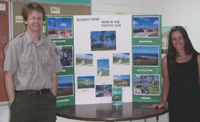 WAPA staff enjoyed giving their presentations and Upi staff and students warmly embraced their National Park Service visitors by showering them with the island hospitality and the kindness so famed on Guam. A CD photo disc, which was produced by the teachers and students of Upi, captured the events of the classroom visit. This CD, which was presented to the Park Service as a gift, had wonderful images of the visit and was set to Chamorro music. This gift was much appreciated by the Park Service as it serves to remind us of our commitment to the island and the joy we receive by living and working with the Guam community. WAPA staff enjoyed giving their presentations and Upi staff and students warmly embraced their National Park Service visitors by showering them with the island hospitality and the kindness so famed on Guam. A CD photo disc, which was produced by the teachers and students of Upi, captured the events of the classroom visit. This CD, which was presented to the Park Service as a gift, had wonderful images of the visit and was set to Chamorro music. This gift was much appreciated by the Park Service as it serves to remind us of our commitment to the island and the joy we receive by living and working with the Guam community.
|
|




